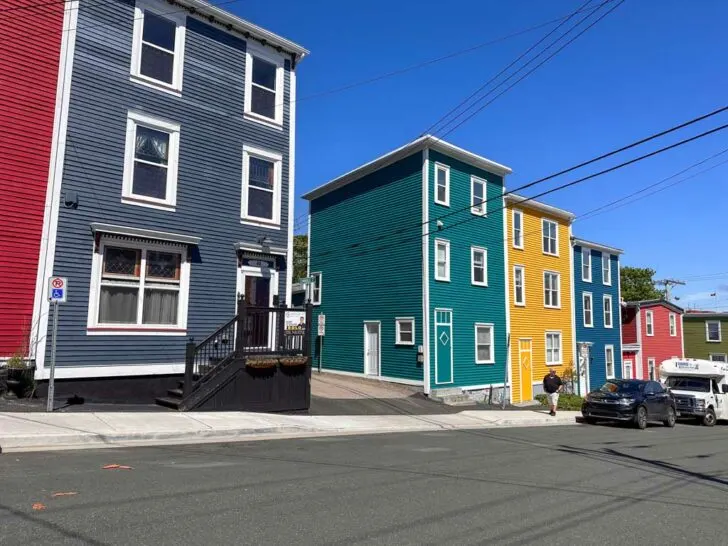Newfoundland is one of my favourite places in the world and after three trips there, I’d say it’s my second favourite Canadian province (behind my home province of British Columbia). If you’re planning a trip, my list of things to do in Newfoundland is a great way to get started.
Newfoundland and Labrador is Canada’s youngest province, joining in 1949. It includes the island of Newfoundland and a section of the mainland called Labrador. Labrador is remote and sparsely populated (and I haven’t been there yet!), so this guide focuses on the island of Newfoundland, home to 94% of the province’s population.
Nicknamed “The Rock”, Newfoundland has gorgeously rugged scenery with a windswept and craggy coastline. It’s also a rural place with tons of whimsically named fishing villages full of brightly painted cottages clustered around small coves. History runs deep here – the province is home to North America’s oldest settlements.
Besides the beautiful scenery, one of the main reasons to visit Newfoundland is the unbelievably friendly people and the unique culture. Since it is is geographically remote, it has its own accent, dialect, food, and traditions.
Since it’s a big place (it takes 7 hours to drive across the island), it can be tough to know where to go. In this post, I’ve got 20 things to do in Newfoundland and lots of travel tips. It includes:
- A map of Newfoundland with every place I mention in this post marked
- Best things to do in Newfoundland: towns, national parks, wildlife, food and more
- Newfoundland travel tips: how to get there, getting around, when to go, what to pack, and more
Hey there: Thanks so much to Go Western Newfoundland for hosting me during the Gros Morne and Corner Brook parts of my second and third trips to Newfoundland. All other parts of my trips were at my own expense and my opinions are my own. Some of the links in this post are affiliate links, which means I earn a small commission at no cost to you. Thanks for your support. -Taryn
Map of Newfoundland
To help you find your way around, I made this custom Google Map of Newfoundland for you. It includes every single place I mention in this post.
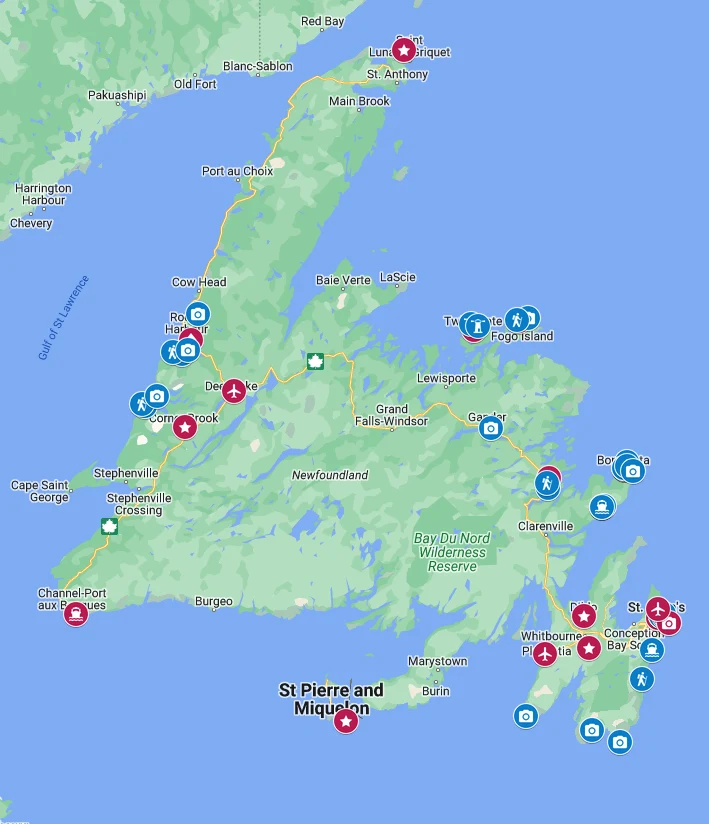
20 Incredible Things to Do in Newfoundland
Explore St. John’s
St. John’s is Newfoundland’s largest city and is also the provincial capital. With its colourful buildings, great food, and welcoming atmosphere, St. John’s is an easy place to love. On two of my trips to Newfoundland, I spent a few days in St. John’s because there was so much to do.
My guide to St. John’s has the full list of things you can’t miss, but here’s a quick run-down of the highlights:
- Jellybean Row: A cluster of downtown streets have rows of colourful houses that make a great photo op.
- The Rooms Museum: A huge museum and art gallery with great exhibits of Newfoundland’s history and culture. It has great views from the top floor.
- Signal Hill: A great viewpoint just outside of downtown that is also a Canadian National Historic Site. You can also hike here on the North Head Trail.
- Quidi Vidi: A quaint, old fishing village in a protected cove near downtown. Today it has a brewery and artist studios.
St. John’s is also a great base for day trips to Cape Spear, Dildo, and the Avalon Peninsula as well as iceberg, whale watching, and puffin tours. (More on all of those below.)

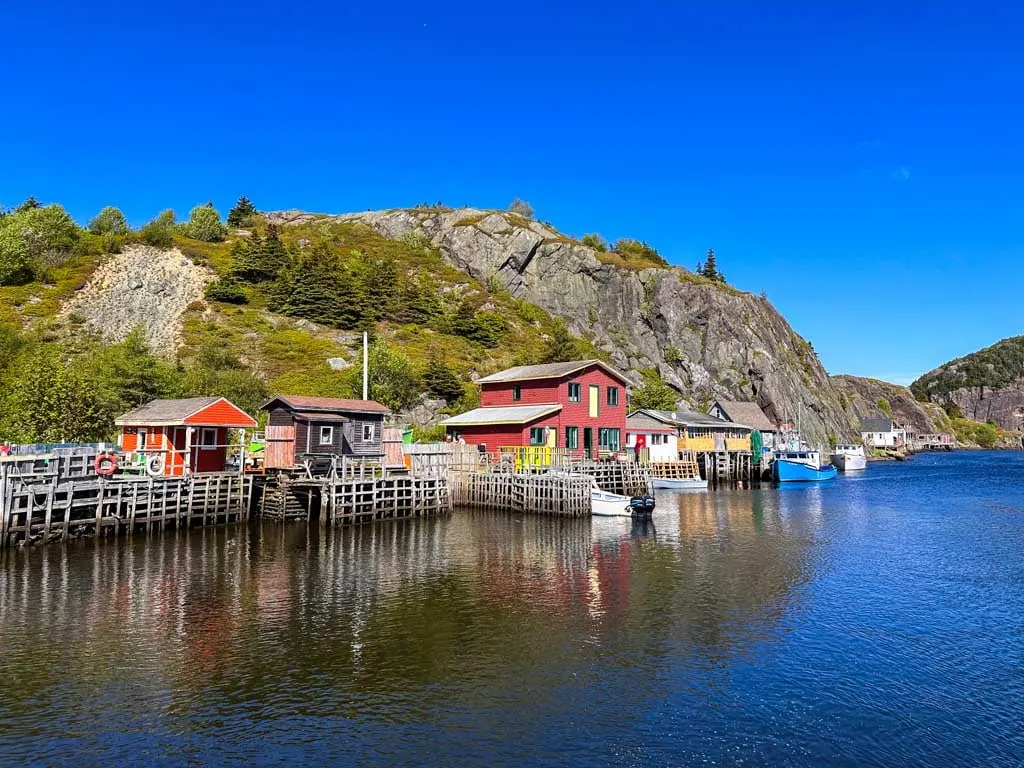
Cape Spear
If you visit Cape Spear, you can say you’ve stood on the easternmost point in North America. But it is also worth visiting for the great views of the coast and the iconic lighthouse, which is the oldest one in Canada and is a National Historic Site.
The cape is just 20 minutes from St. John’s. The best way to get there is to drive yourself or to take a tour. The last time I was in St. John’s I visited Cape Spear as part of the City and Cape tour with McCarthy’s Party. It’s a great tour that hits the highlights in the city and then takes you out to Cape Spear.
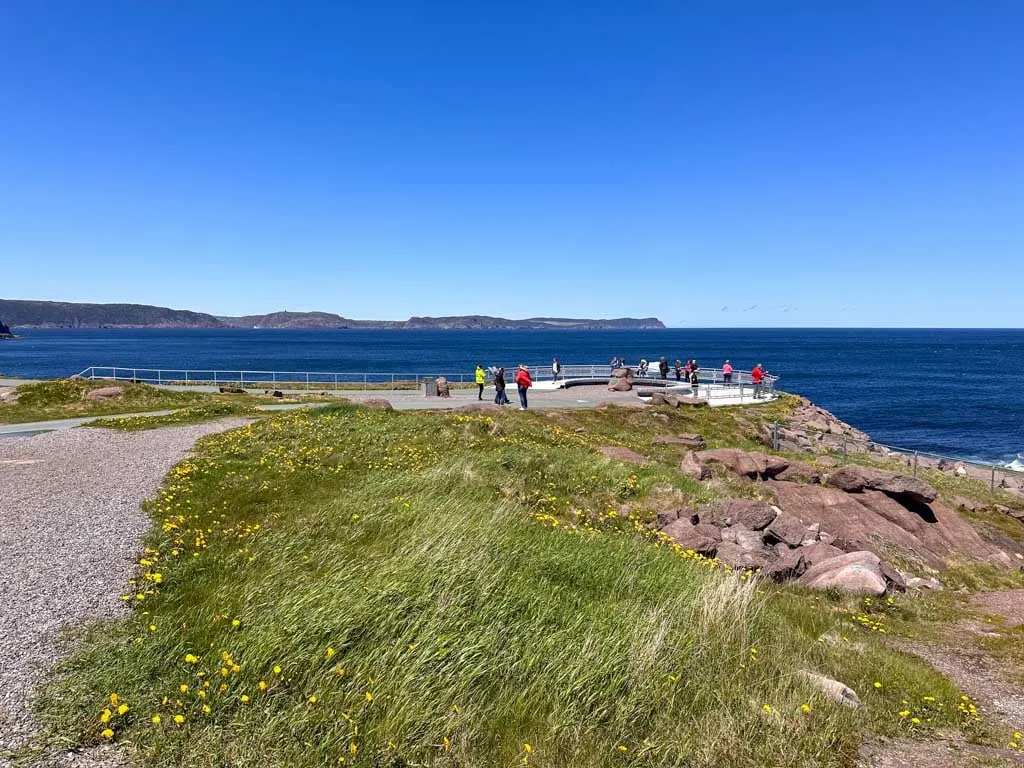
Dildo
Yes, Newfoundland has a town named Dildo! If you want to visit, it’s a little over an hour outside of St. John’s. Honestly, it would be like any other small town in the province if it wasn’t for the name… but that name has brought the town lots of fame.
The town had been a popular tourist spot for years, thanks to various tongue-in-cheek articles. And in 2019, Jimmy Kimmel did several bits about Dildo on his late-night talk show. In the end, the town made him the honourary mayor and he paid to erect a huge Hollywood sign-style sign spelling out “Dildo” on a hill above town.
There isn’t much to see in Dildo, but it’s still fun to grab photos of the sign. You can also head to Dildo Brewing, which has craft beer and pub food. If you need cheeky souvenirs, both Dildo Brewing and Nan and Pop’s Dildo Souvenir Shop can help you out.
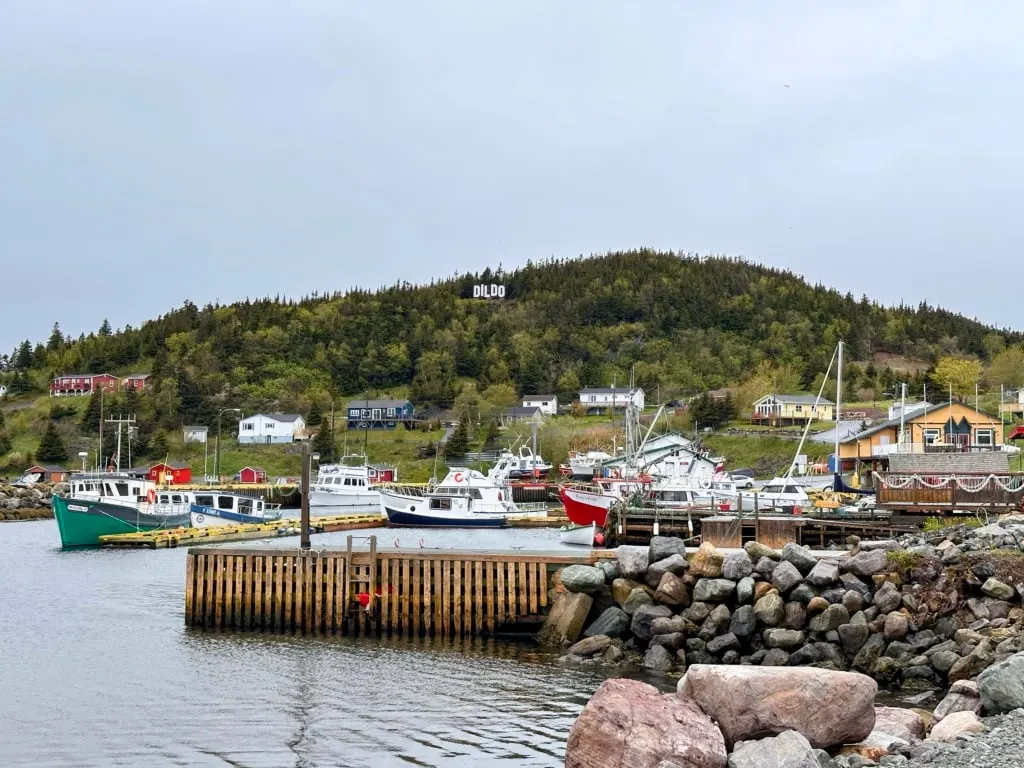
Avalon Peninsula
I have to admit that despite three trips to Newfoundland and over a month spent in the province… I haven’t really been anywhere on the Avalon Peninsula besides St. John’s, Cape Spear, Bay Bulls (for a puffin tour), and the Argentia ferry terminal.
And that’s entirely my fault. I’ve heard great things about the area, I just haven’t made time to visit. In fact, it’s one of the most popular tourist areas in the province since it’s an easy drive from St. John’s. Highlights include bird watching at Cape St. Mary’s Ecological Reserve, fossils at Mistaken Point, puffins, whales, and icebergs in Bay Bulls, roadtripping along the Irish Loop, and hiking the East Coast Trail.
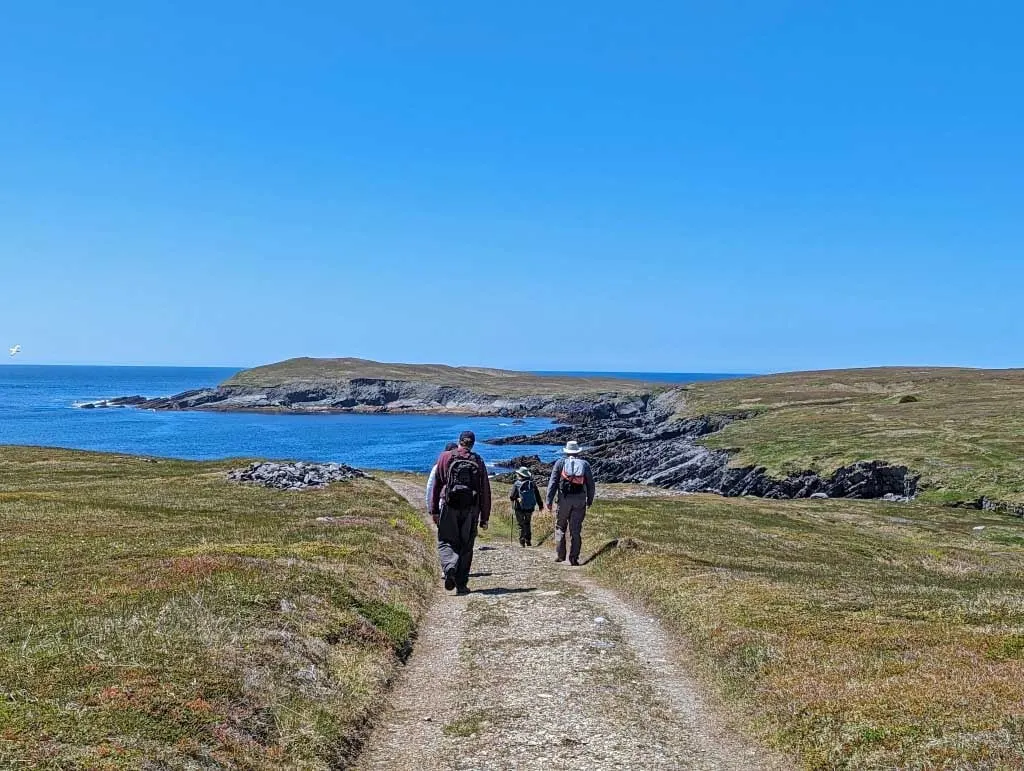
Trinity
Trinity is the prettiest town in Newfoundland. It’s a tiny place, tucked into a protected harbour at the end of a narrow peninsula about 3 hours from St. John’s. Historically, it was one of the most important merchant fishing towns in the province. Today, the remaining buildings are protected as heritage sites and most of the town is geared towards tourists.
That gives Trinity a bit of Newfoundland-meets-Disney feel. That could be cheesy, but I think they’ve done a good job of respecting the heritage and making things feel authentic.
My guide to Trinity has lots of things to do as well as all the info you need to visit.
The main draw in Trinity is the town itself. I recommend giving yourself an hour or two to just wander around and gawk at all the adorable old houses.
The other big attraction is the Rising Tide Theatre, which stages several Newfoundland-themed plays each summer. They also offer a popular walking tour/theatre performance.
If you’re into the outdoors, Trinity also has good kayaking and hiking (don’t miss the Skerwink Trail one of the best hikes in Newfoundland) as well as boat tours to see whales and icebergs.
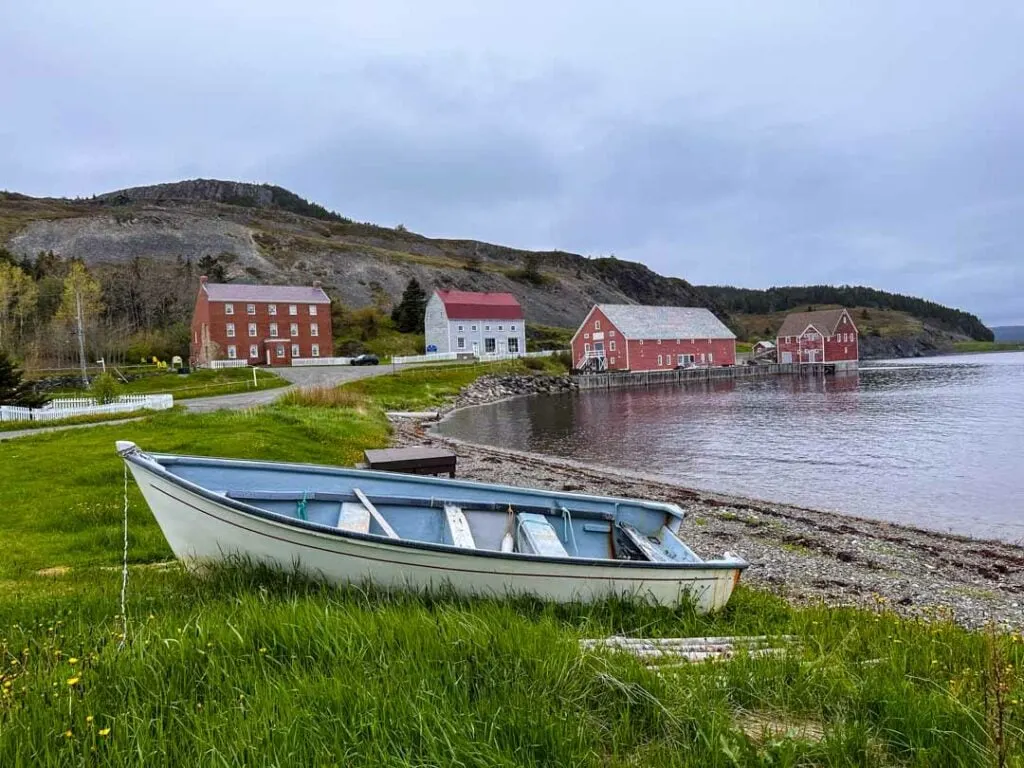
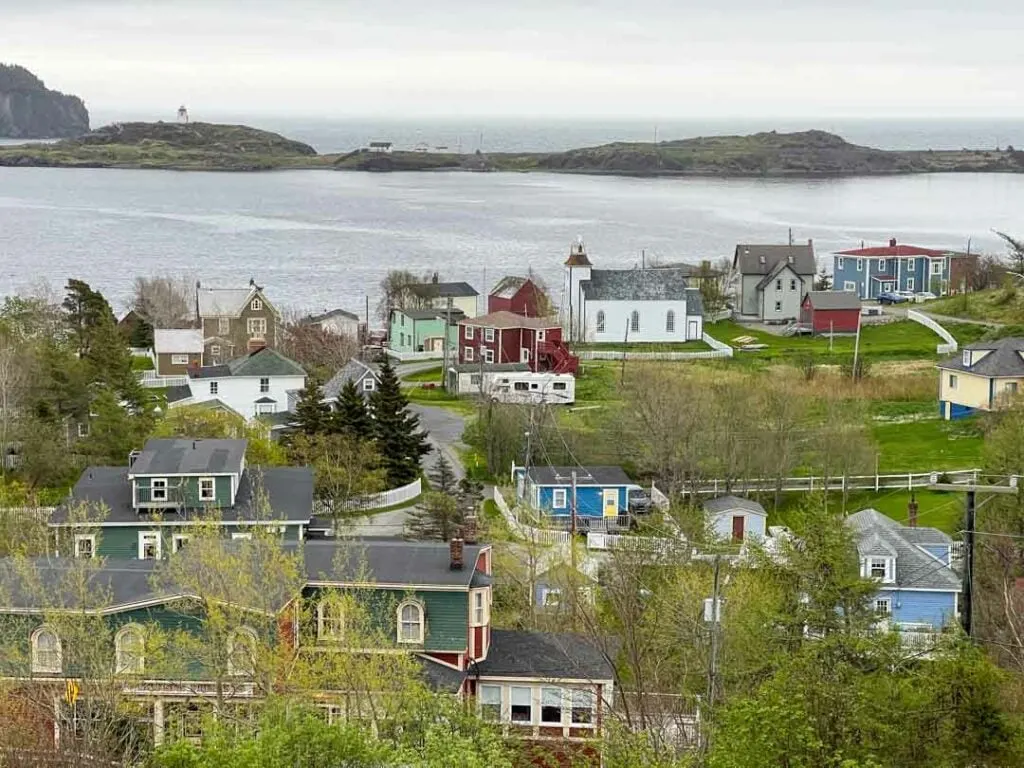
Bonavista
Just up the road from Trinity is Bonavista, my favourite town in Newfoundland. While Trinity is picture-perfect and lovingly restored, Bonavista is equally old, but a bit rougher around the edges. I love the juxtaposition of falling-down buildings with newly refurbished ones. Bonavista is also a real working town with 3000 residents (compared to just 78 in Trinity).
Read my guide to Bonavista for more must-sees in the area as well as lots of travel tips.
The biggest draw is the Bonavista Lighthouse just north of town. The striped facade is on countless postcards, teatowels and even mailboxes all across the island.
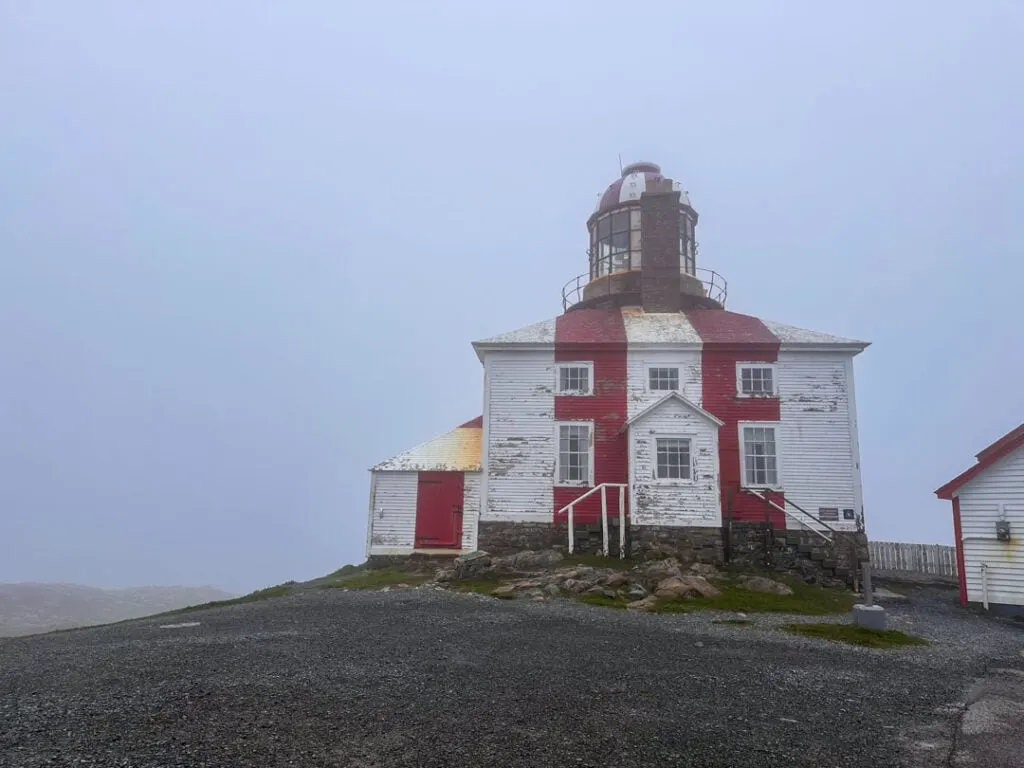
You also should visit some of the historic sites in town. On my first visit, we toured the Ryan Premises, which is a National Historic Site. Its exhibits, housed in a 19th-century building, explain the history of fishing in Newfoundland. Other historic sites include the Matthew Legacy, a reproduction of John Cabot’s ship, and the Mockbeggar Plantation, a collection of historic buildings.
If you venture a few minutes outside of Bonavista, you can visit the unique cliffs and caves of Dungeon Provincial Park. Or drive a few minutes further to Elliston, the best place to see puffins from land.

St. Pierre and Miquelon
Did you know you can go to France from Newfoundland? The tiny islands of St. Pierre and Miquelon sit just south of central Newfoundland. Founded by French fishermen, the islands are still part of France: the 5,800 residents speak French and use the Euro.
I’ve always wanted to visit the islands, but I haven’t made it yet. To get there you can fly from St. John’s or take a 90-minute ferry from the town of Fortune, which is a 4-hour drive from St. John’s.
Besides the novelty of visiting France, the islands offer cute towns, small museums, boat tours, and stunning nature.
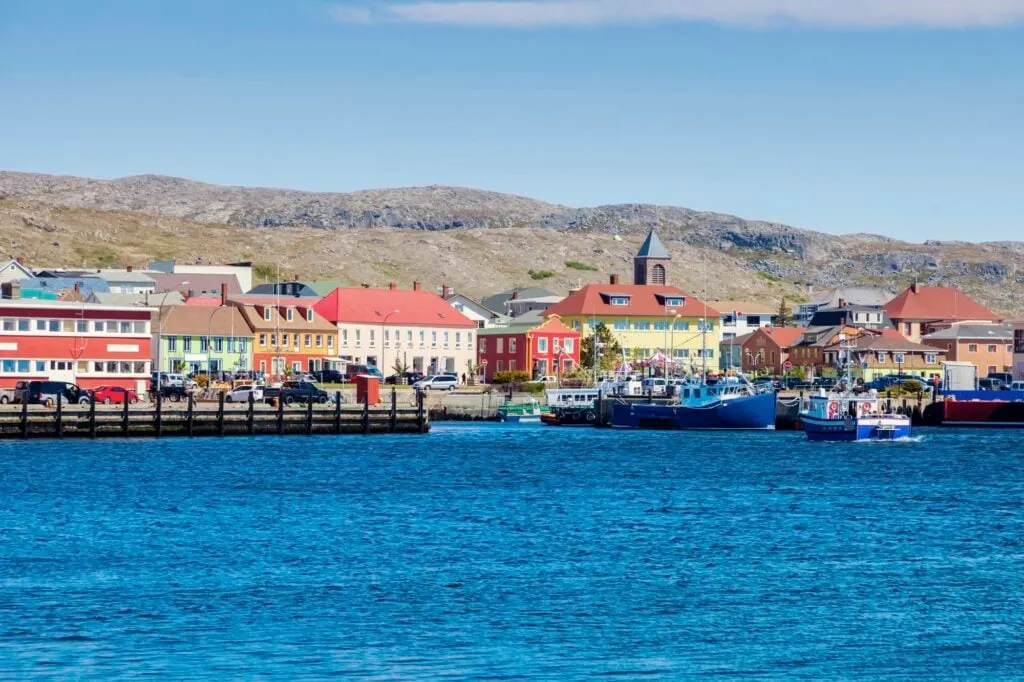
Terra Nova National Park
Unless you’ve been to Newfoundland, you probably haven’t heard of Terra Nova National Park. Compared to stand-outs like Banff, the subdued beauty of Terra Nova just doesn’t get the same press. But it’s still a gorgeous park. It is about 3 hours from St. John’s just past the Bonavista Peninsula.
The park protects vast swaths of coastline, mudflats, and rolling hills. Most visitors will concentrate their time around the Visitor Centre, which has great exhibits about wildlife including touch tanks where you can get up close to sea life.
For great views, make the short drive from the highway to the Ochre Hill Fire Tower. There are several wooden platforms, but if you’re brave, scale the steps to the top of the tower. It was windy on my visit, which added to the thrill/terror.
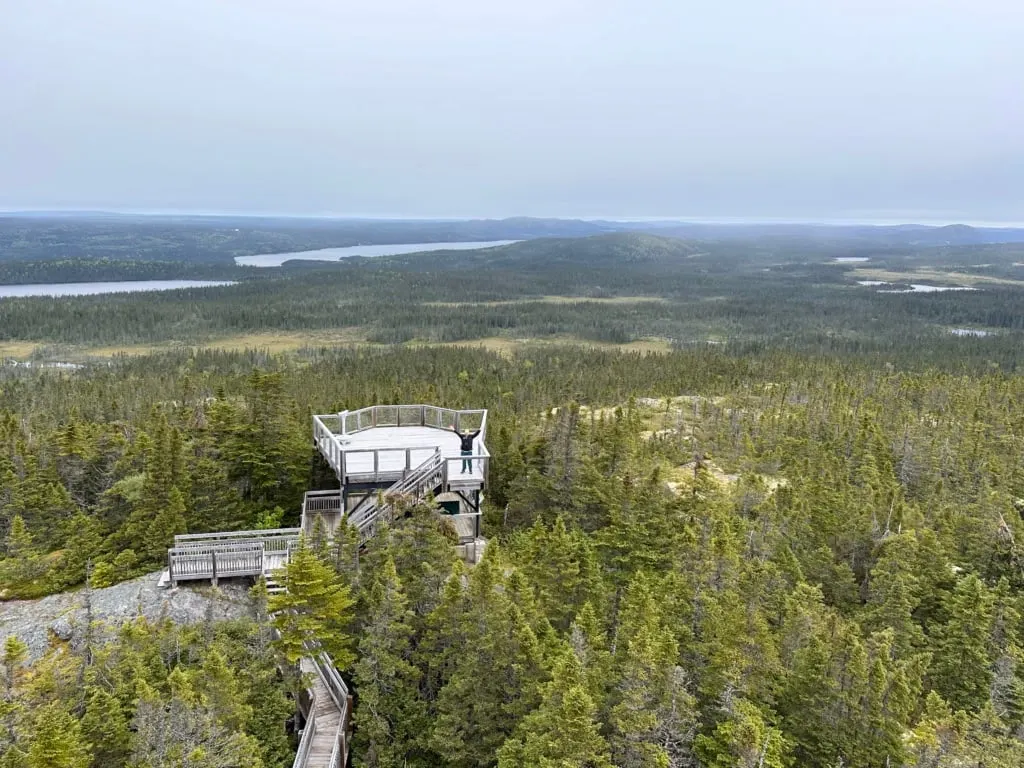
If you like hiking, the park has over 80 km of trails. I enjoyed the Coastal Trail, which made my list of the best hikes in Newfoundland.
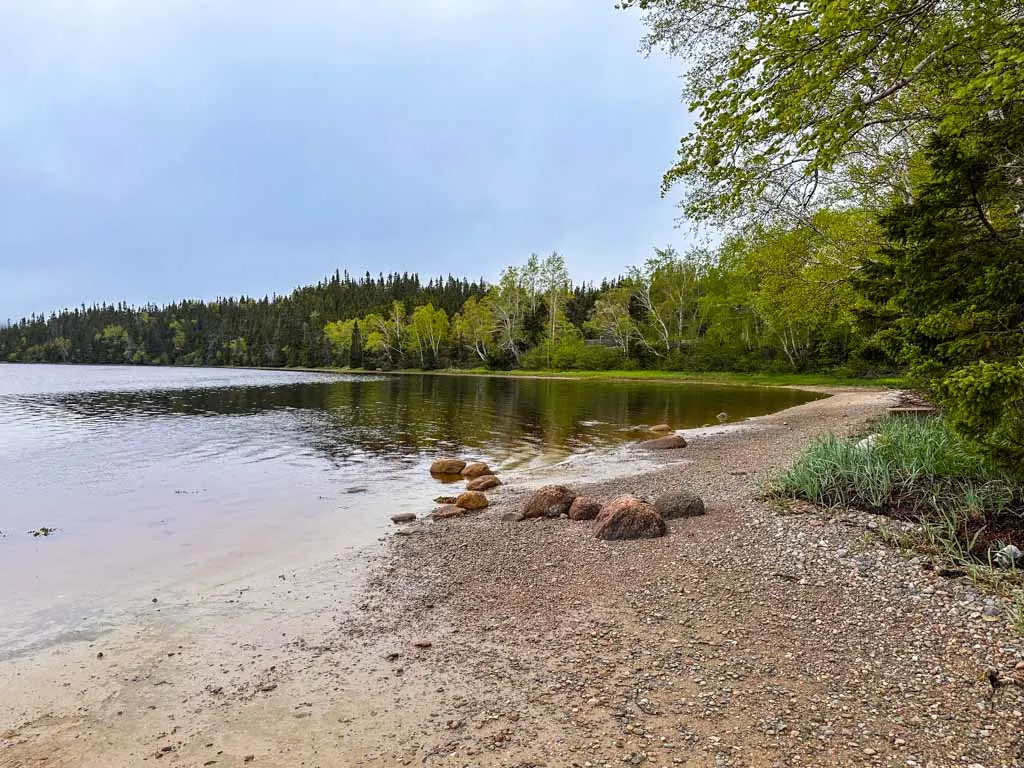
Twillingate
Twillingate is a tiny town in the centre of the province. It sits on a pair of rocky islands and since it’s on the windswept northern coast, it has a rugged and austere beauty that sets it apart from other charming towns like Trinity and Bonavista.
Part of its charm is its isolation. Twillingate stis on the north coast amongst a a cluster of other fishing villages. It’s 5 hours from St. John’s or 4.5 hours from Corner Brook, but I think it’s worth the journey.
Most of the area around Twillingate had no roads until the 1950s and 60s, which means that everything is oriented towards the sea and strung out along the waterline.
My guide to Twillingate has tips for visiting along with lots of things to do.
Twillingate bills itself as the iceberg capital of the world since it’s right in the path of the currents that bring them south from Greenland. It’s often possible to see icebergs from land, but there are several iceberg boat tours as well.
Like other cute towns in Newfoundland, one of the main things to do here is to wander around and admire the old buildings. The nearby Long Point Lighthouse is also worth a visit. And if you like, there are several small museums in the area.

But my favourite reason to spend time in Twillingate is the hiking. The trails range from short and simple to longer and more challenging, so there is something for everyone. The Rockcut Trails are gorgeous, especially the hike to French Head, which made my list of the best hikes in Newfoundland.
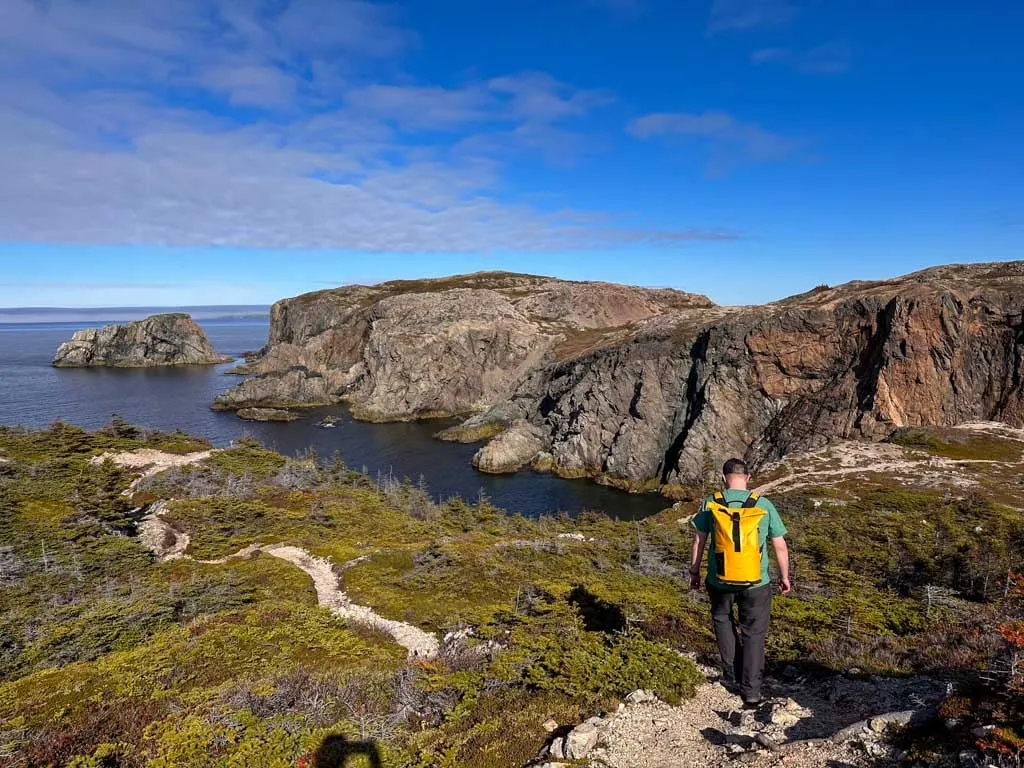
Fogo Island
I didn’t get to Fogo Island on my first trip, but after we visited it on our second trip to Newfoundland I was kicking myself for not going sooner. Fogo is so unique! The only way to get to this small island near Twillingate is by ferry.
Check out my Fogo Island guide to learn more about visiting and more must-sees on the island.
For decades after the collapse of the cod fishery, the island stagnated. But in the last decade or two, a revitalization project and social enterprise have transformed Fogo. Today it has a network of excellent hiking trails, nine picturesque towns to explore, and a thriving arts scene with artisans, galleries, and studios you can visit.
The backbone of the social enterprise project is the Fogo Island Inn, an ultra-luxury hotel catering to wealthy guests with high-end food and lots of included day tours. However, you don’t have to stay at the hotel to enjoy it – you can take a free tour to get a close-up look at the interesting architecture.

The hiking on Fogo is some of the best in the province. The barren landscape is gorgeous and allows for lots of views. The trail to the top of Brimstone Head made my list of the best hikes in Newfoundland.

Corner Brook
I know Corner Brook doesn’t make some people’s lists of the best things to see in Newfoundland… but it should. Corner Brook is the second largest city in the province and by far the biggest city in the western part of the province.
While it is a regional hub for government and business, it also has a scrappy small outdoor town feel with incredible access to nature and an up-and-coming food scene with craft beer and good coffee.

My guide to Corner Brook has a full list of things to do and tips for visiting.
Corner Brook is a great place to base yourself for a day trip to the nearby Bay of Islands region which has incredible hiking and kayaking along with some really cute old fishing villages like Little Port. The entire region is part of the aspiring Cabox UNESCO Global Geopark to recognize its exceptional geology. The South Head Lighthouse Trail is on my list of the best hikes in Newfoundland.
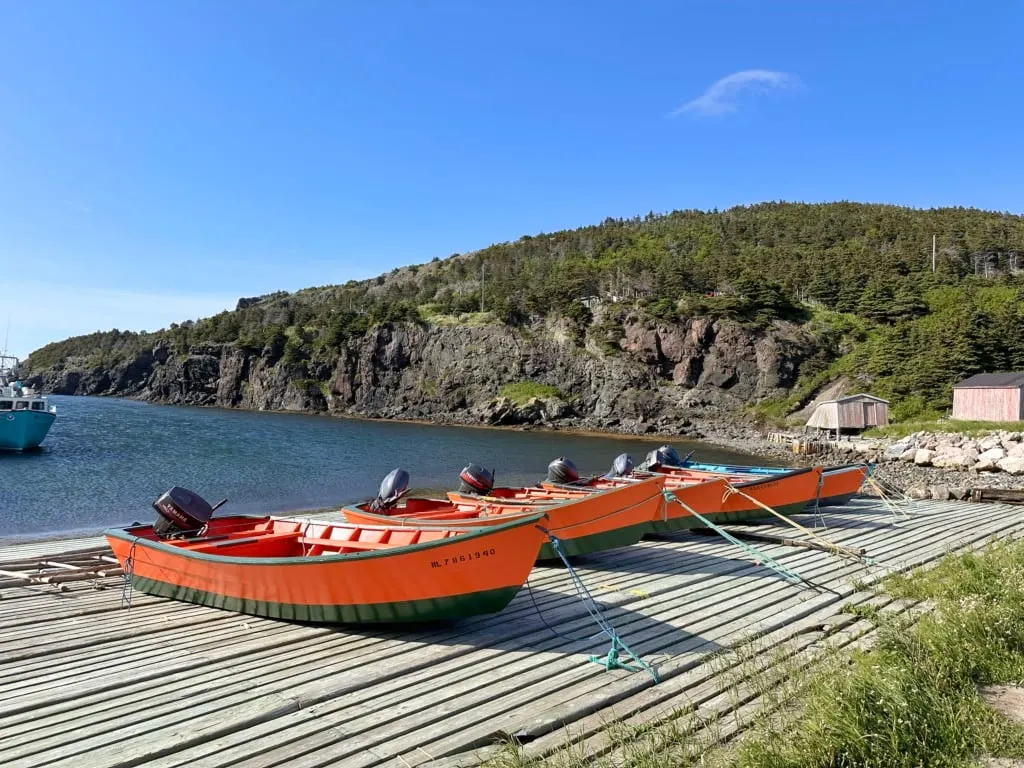
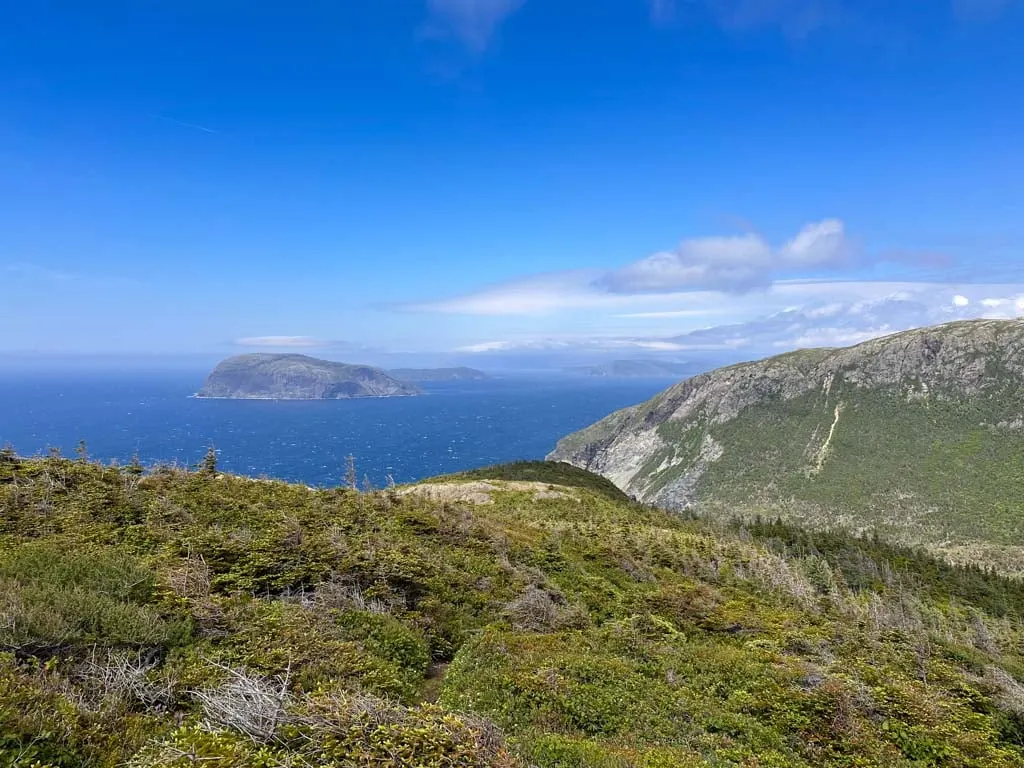
Gros Morne National Park
Located in Western Newfoundland near Corner Brook, Gros Morne National Park is gorgeous – if you’re interested in hiking and the outdoors, it’s worth coming to Newfoundland just to visit this park. The park is fairly large, spreading across the coastline and over mountain ranges. It also includes a few charming small towns.
If you’re thinking of visiting, read my guide to Gros Morne National Park, which has lots of trip planning advice and more things to do.
There are a few key highlights in Gros Morne:
- Tablelands: Hike over rocks from Earth’s mantle exposed at the surface.
- Green Gardens: A hike to the coast through a forest so lush that it reminded me of Hawaii.
- Bonne Bay: A deep inlet cutting through the middle of the park, best appreciated from a boat tour.
- Western Brook Pond: A former fjord that is now a lake. Take a boat tour to appreciate the steep terrain rising up from the lake.
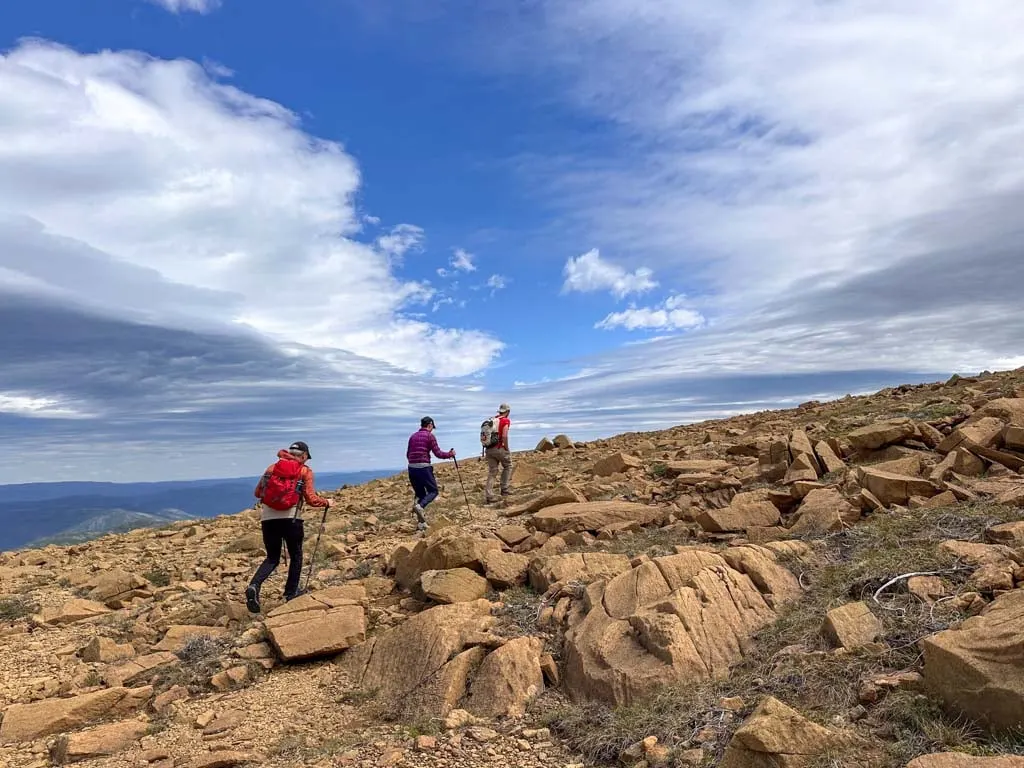
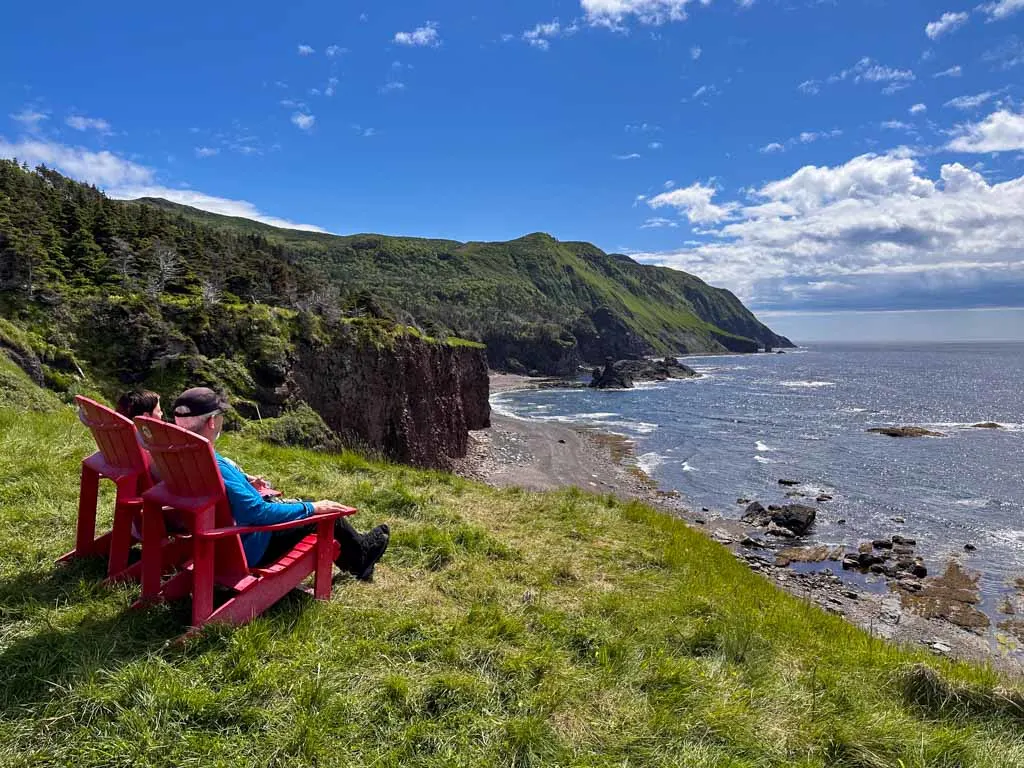
L’Anse aux Meadows
Most people learn that the first European to visit the American was Christopher Columbus. However, in the 1960s, archaeologists discovered evidence of a 1000-year-old Norse settlement at L’Anse aux Meadows near the northern tip of the island. That means the Vikings beat Columbus to North America by nearly 500 years!
Today, L’Anse aux Meadows is a Canadian National Historic site and UNESCO World Heritage site. I made the long drive up there (5.5 hours from Corner Brook) on my first visit to Newfoundland. The site protects the remains of the Norse buildings and also has reconstructed buildings and interpretive displays.
I spent a fun day wandering around and chatting with the costumed actors who reenact Viking life. It’s a fascinating place, and while it’s tough to get to, I thought it was worth it.
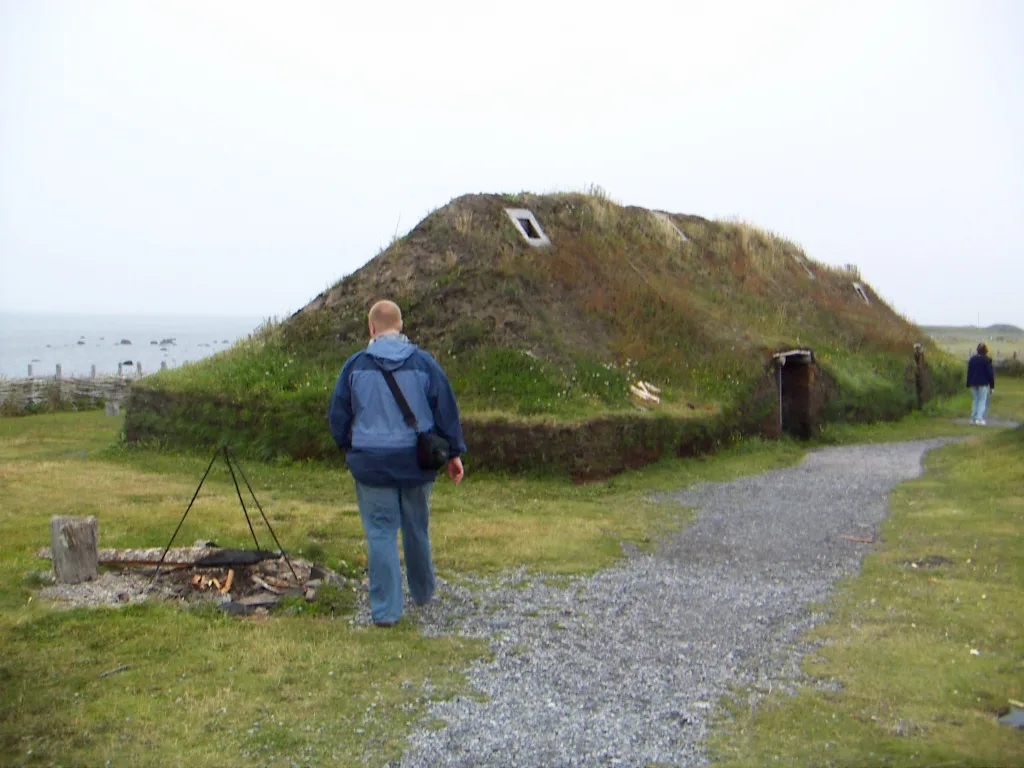
Road Tripping
On two of my visits to Newfoundland we drove across the island on an epic road trip. With lots of paved roads, tiny towns, and viewpoints, Newfoundland is an ideal road trip destination.
One of the most popular itineraries includes is an east-to-west (or vice versa) trip across the province between St. John’s and Gros Morne National Park.
If you want to take a shorter trip, you could drive around the East Coast hitting up St. John’s, the Avalon Peninsula, and the Bonavista Peninsula. Or stick to the West Coast by visiting Corner Brook, Gros Morne National Park, and L’Anse aux Meadows.
Whichever itinerary you choose, leave lots of time for unexpected stops. We found ourselves pulling over to take photos, explore villages, and stop at small cafes.
You can also visit out-of-the-way attractions, like the International Lounge at the Gander Airport, where it is still 1959 and the age of transatlantic air travel is brand new. (They also have exhibits about the flights that landed here on 9/11 and inspired the musical, Come From Away.)

Whale Watching
While I haven’t been whale watching in Newfoundland, I’ve heard great things. (I skipped whale watching on my trips since I live in BC and have been kayaking with whales.) Since Newfoundland is way out in the Atlantic, it’s right on lots of whale migration routes including the annual summer migration of humpback whales. You can also see other species of whales and dolphins.
Many boat tours combine whale watching with spotting icebergs and seabirds like puffins as well as touring the picturesque coastline. (More of puffins and icebergs below)
The most popular place to take a whale watching tour is Bay Bulls and Witless Bay about 30 minutes south of St. John’s. You can also book whale watching tours in Trinity and Twillingate.
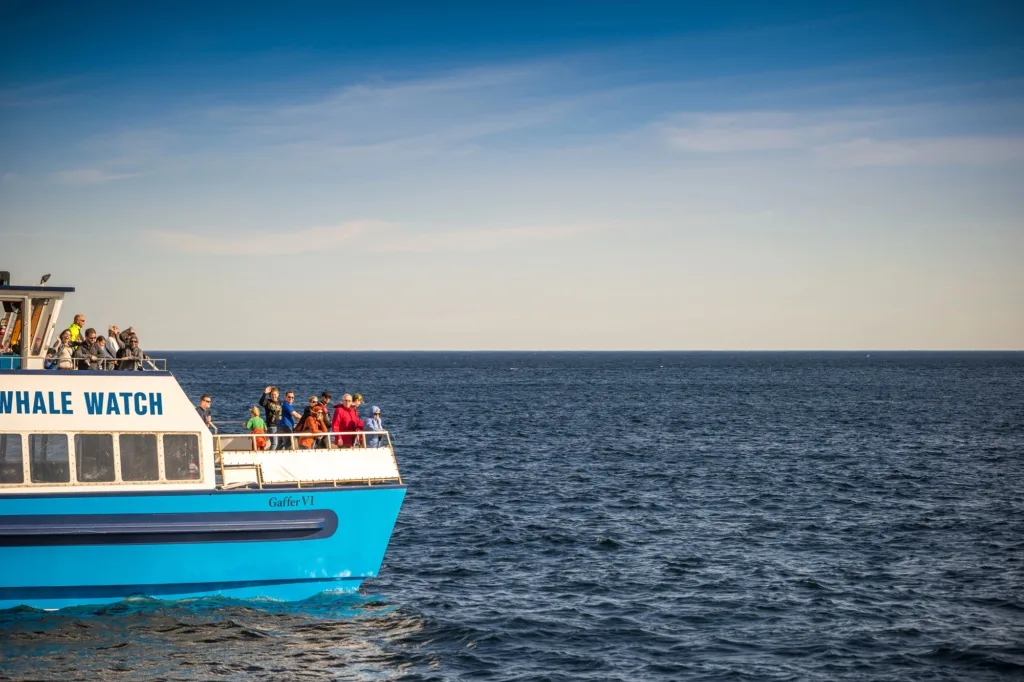
Icebergs
One of the coolest things to do in Newfoundland is iceberg viewing. (Sorry, I couldn’t resist the pun!) In spring and early summer, icebergs drift south from Greenland towards Newfoundland along a rough path called Iceberg Alley.
The best time to go iceberg spotting is May and June. We didn’t see any icebergs on my first trip to Newfoundland since we were there in August. But we planned our second visit for June in the hopes of seeing one.
Often you can see the icebergs from land (binoculars help), but nothing beats seeing them up close on a boat tour. The north coast of the province is the best place to see them but it’s also possible to see icebergs near St. John’s.

The icebergs aren’t predictable and move every day. In some years icebergs are plentiful, while in others (like the year I visited) there aren’t that many around. You can book iceberg tours in Bay Bulls near St. John’s or in Trinity, but for the best chance of seeing them, I recommend going to Twillingate or other small North Coast towns.
You can use Icebergfinder.ca to get the latest locations for icebergs you can see from land or via a tour. I found the Newfoundland and Labrador Iceberg Reports Facebook group super helpful on my trip. It was updated more often than Icebergfinder and it had up-to-date reviews on boat tours.
We went to Twillingate looking for icebergs but there weren’t any. So, we used the info from the Facebook group to find out that there was an iceberg in a bay near a tiny town called Brighton 3.5 hours away. We also got a recommendation for a local tour guide (Clarey of Badger Bay Boat Tours). We booked a B&B, then made the drive.
It was incredible to see the iceberg up close and we got to experience a part of Newfoundland that not many tourists see since it was so off the beaten path.

Puffins
Puffins are adorable so they get the most press, but you can also see tons of other bird species in Newfoundland. The best time to see puffins is the summer nesting season between mid-May and late September – they head down south and out to sea the rest of the year.
The first time I went to Newfoundland I wasn’t that into birding. We took a boat tour and saw the puffin colonies from the water. I got hooked on these clown-like birds with their wobbly walk that contrasts with their grace once they dive under the water. Since then I’ve seen puffins in Iceland and Haida Gwaii, BC. So of course, on my next trip to Newfoundland, we looked for puffins everywhere we could.
The most popular way to see puffins is to take a boat tour in Witless Bay and Bay Bulls which combines puffin spotting with whale watching. (They might also take you to see icebergs in the spring/early summer iceberg season.)
But you can also see puffins from land in a few places near Bonavista. As a bonus, it’s totally free and there’s a zero percent chance you’ll get seasick.
I think the best place to see puffins from land is at the Elliston Puffin Viewing site near Bonavista. We had puffins walking right up to us! You can also see puffins from land at the Bonavista Lighthouse and on the Klondike Trail (one of my picks for the best hikes in Newfoundland.
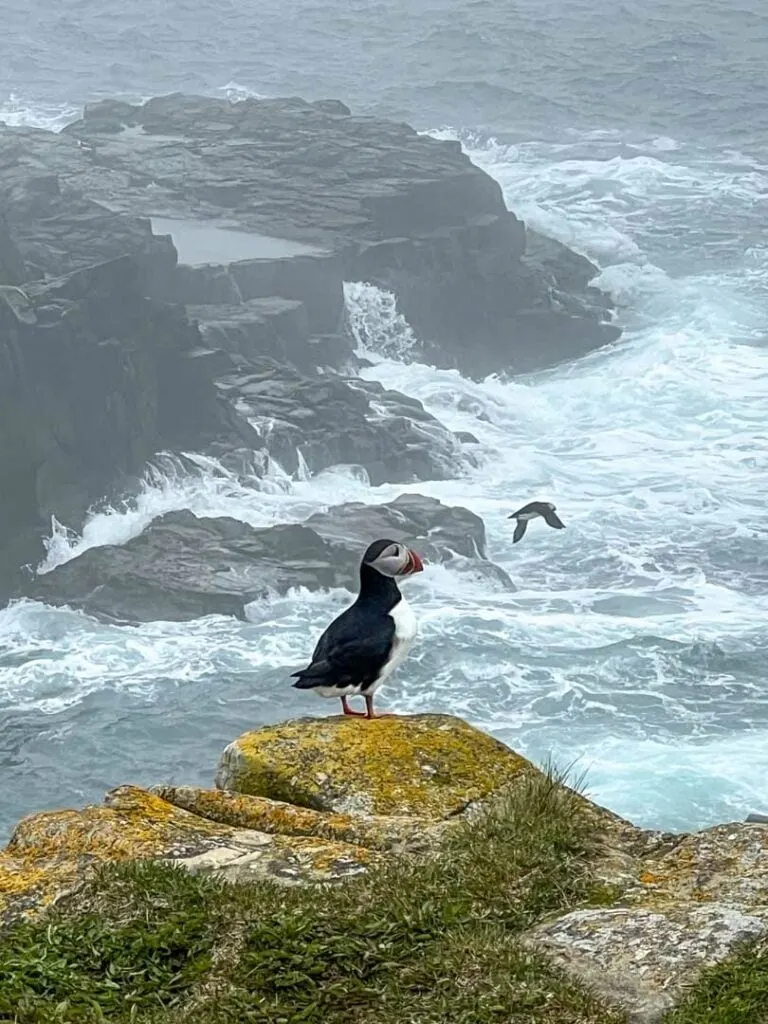

Hiking
The main reason I have been to Newfoundland three times is to go hiking – the province has incredible trails. While there are long and challenging trails, most routes are easy to moderate and take half a day or less. That makes them perfect for tourists since you can go for a beautiful hike but still have lots of time for sightseeing.
My list of the best hikes in Newfoundland includes my top 16 hikes across the province.
There are gorgeous trails all over the island – you can even hike up Signal Hill in the heart of St. John’s on the North Head Trail. But if you want to spend a lot of time hiking, I recommend you concentrate your stay around the hikes in Gros Morne and Twillingate, my two favourite hiking areas.
READ MY PICKS FOR THE BEST HIKES IN NEWFOUNDLAND

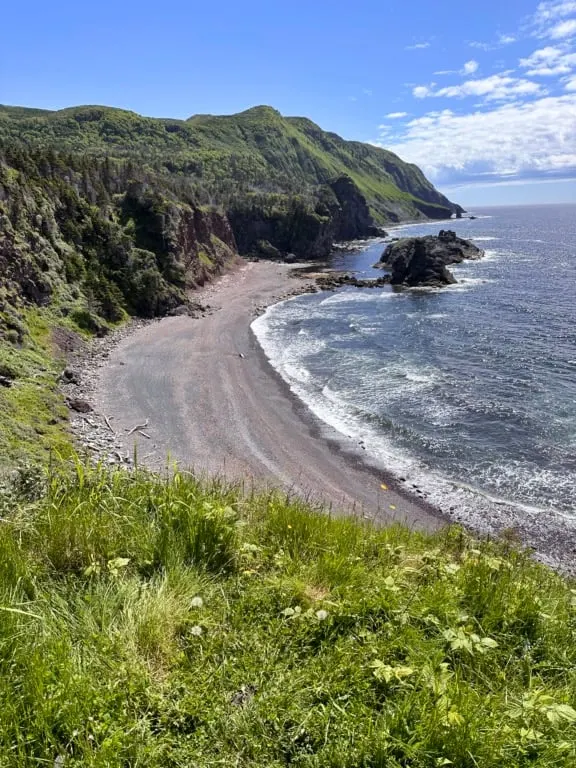
Get “Screeched In”
The Newfoundland tradition of getting “screeched in” is a quirky ceremony that welcomes visitors (known as Come From Aways). The ritual involves taking a shot of Newfoundland rum, called screech, kissing a codfish (which is usually frozen) and eating a cube of bologna (nicknamed Newfoundland Steak).
It’s a silly tradition that’s mostly for tourists, but it’s also lots of fun. The best place to get screeched in is at one of the bars on George Street in St. John’s. However, you can get screeched in at bars and tourist businesses across the province. If you take a multi-day bus tour in the province, it will almost always include getting screeched in.
Unique Newfoundland Food and Drink
Since Newfoundland is so isolated and has only been part of Canada since 1949, it has a distinct food culture. Like most coastal places dominated by the fishing industry, it has world-class seafood. But it also has some quirky Newfoundland food and drink that you have to try.
You can find Newfoundland-style cuisine on restaurant menus everywhere from small towns to the city. A trip to the grocery store is also an experience to see what Newfoundlanders actually eat.
Some restaurants I recommend across the province include:
- Chafe’s Landing in Petty Harbour near St. John’s for lobster rolls
- Mifflin’s Tea Room in Bonavista for fish n’ brewis or toutons
- Annie’s Harbour Restaurant in Twillingate for cod tongues
- Bangbelly Bistro on Fogo Island for modern takes on traditional Newfoundland food
- Boomstick Brewing in Corner Brook for craft beer
- The Salt Box in Bay of Islands for seafood, moose tacos, and more
- Seaside Restaurant in Trout River for fried fish
- Chanterelle’s in Norris Point for partridge berry cheesecake
Here’s a quick list of some uniquely-Newfoundland foods you have to try:
Appetizers and Sides:
- Cod tongues: Deep-fried cod tongues have a texture a bit like calamari with a cod flavour.
- Fries with dressing and gravy: Like Quebecois poutine but instead of cheese curds they put turkey stuffing (dressing) on top of the fries, then pour gravy over top.
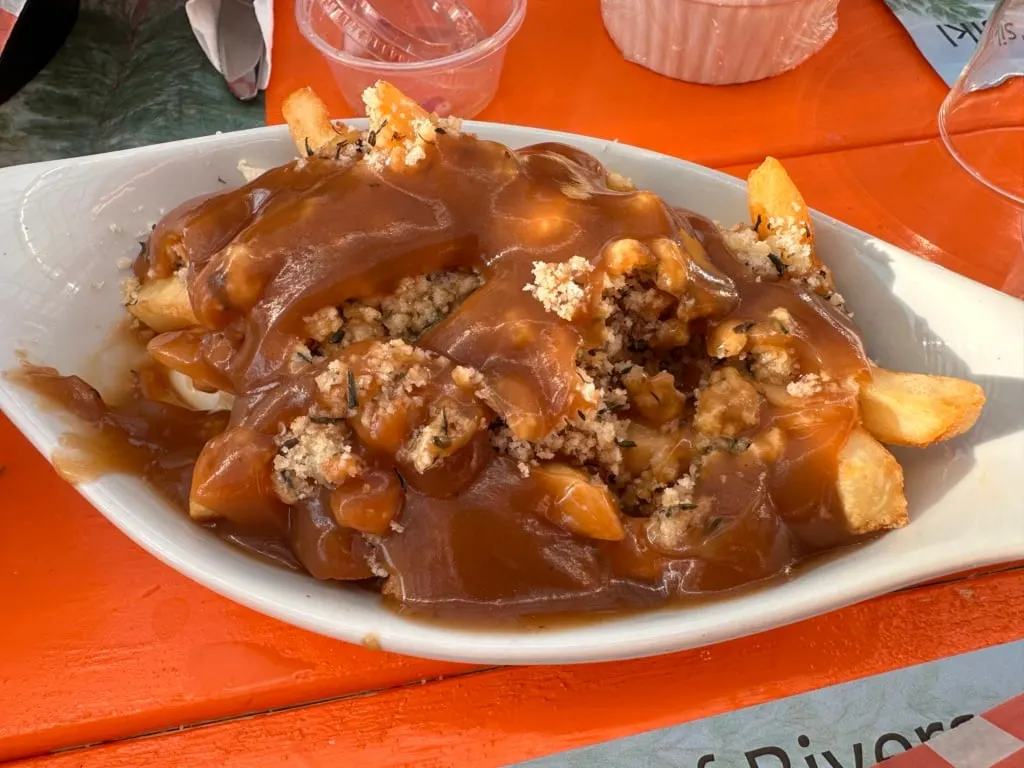
Mains
- Fish and brewis: a mash of soaked salted cod and hard tack bread with fried pork fat on top
- Moose: Newfoundlands love to eat this invasive species and put the lean meat into burgers, pasta sauce, tacos, and more
- Jigg’s Dinner: a traditional Sunday meal of salt beef boiled with cabbage, potatoes, and carrots
- Flipper pie: A pot pie made with seal flipper meat. It has a VERY strong fishy taste that not everyone will like.
- Fish n’ Chips: This is not unique to Newfoundland but what is unique is how prevalent it is. I dare you to find a menu in the province that does NOT include fish n’ chips!
- Mary Brown’s Chicken: This fried chicken chain started in Newfoundland and now has hundreds of locations across Canada. It’s so pervasive in the province that you can find locations in some of the provinces’ small, remote towns.

Desserts
- Bakeapples: also known as cloudberries, they taste a bit like blackberries and are often made into jam or pies
- Partridge berries: A bit like cranberries, these are also often found in jams, pies, and baked goods
- Toutons: fried yeasted dough eaten with molasses, syrup or jam, usually for breakfast
- Purity candy: This 100-year-old Newfoundland company makes several types of old-school hard candy including Peppermint Nobs and their infamous Climax Mix
- Jam Jams: Packaged sponge cookies with a jam filling.
- Crush Pineapple: A sickly sweet soda, like Crush Orange but with pineapple flavour instead of orange.


Newfoundland Travel Tips
History of Newfoundland
Indigenous Beothuk and Mi’kmaq people have lived on the island of Newfoundland since time immemorial. In 1497 when John Cabot landed at Bonavista, he “claimed” it for England. In the next few centuries, Basque, Portuguese, and French fishermen frequented the waters and set up small fishing settlements.
Newfoundland became an English colony in 1713 under the Treaty of Utrecht and English settlement begun in earnest. By the 1930s, Newfoundland’s economy was in trouble. In 1949, Newfoundlanders voted to join Canada as the 10th province.
Historically, cod fishing was the backbone of the province’s economy. However, the cod fishery collapsed in 1992, leading to widespread poverty. Today fishing for other species dominates the economy along with oil and gas, mining, and of course, tourism.
Since Newfoundland is geographically isolated, it has a unique culture that blends aspects of England, Ireland, and Canada. Newfoundlanders also have a distinct accent that sounds a bit Irish, and a distinct vocabulary, sometimes called Newfoundland English or Newfinese.
How to Get to Newfoundland
Since it is an island, the only way to get to Newfoundland is to fly or take a ferry.
The main airports are in St. John’s and Deer Lake near Corner Brook. You can get direct flights from major Canadian cities like Toronto, Montreal, Halifax, Ottawa, Calgary, and Edmonton.
It’s also possible to get to Newfoundland by ferry. This option makes the most sense if you driving your own car or RV. There are two ferry terminals: Argentia in the east is 1.5 hours from St. John’s. Port aux Basques in the west is 2.5 hours from Corner Brook. Both ferries leave from North Sydney in Nova Scotia.
Travel times by ferry are long: it’s six to eight hours to Port aux Basques and 15 hours to Argentia.
Getting Around Newfoundland
Newfoundland is big so you can expect long travel times between locations. For example, if you drive across the province from St. John’s to Corner Brook, it takes about 7 hours without stops.
Unless you are sticking around St. John’s or taking a multi-day tour, the only real way to see the province is to rent a car since the only long-distance bus service misses most tourist spots. You can rent a car at the airport in St. John’s or Corner Brook. Heads up: rental cars in Newfoundland are expensive and they book up in summer!
Driving in Newfoundland is fairly straightforward since there aren’t that many roads. The Trans Canada Highway that runs across the island is wide and well-maintained, which makes for easy travel. However, I can’t say the same about many of the smaller highways. Expect twists and turns and lots of potholes. You will often need to travel well under the speed limit.
The weather is very changeable so be prepared to drive in heavy rain or thick fog. You will also want to avoid driving at night since there are more moose than people on the island and collisions with moose are one of the main causes of serious car crashes.
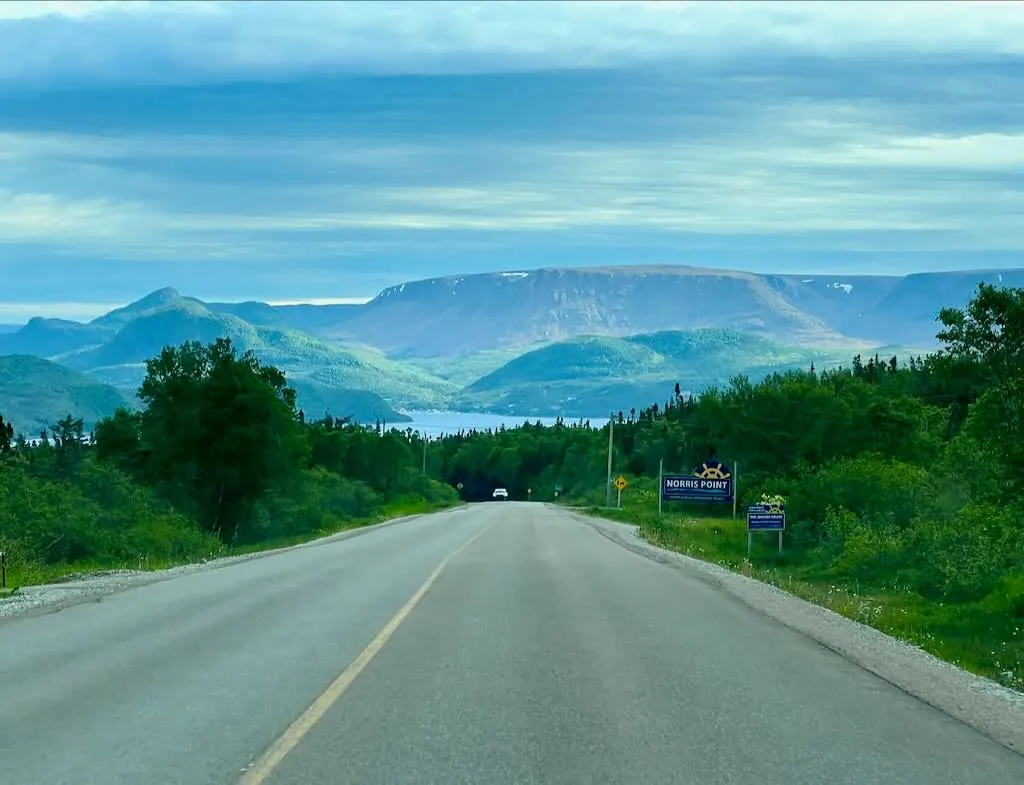
How Long to Spend in Newfoundland
Each time I’ve gone to Newfoundland I’ve spent about 10 to 14 days there. It’s enough time to road trip across the island as well as spend a few days in St. John’s and Gros Morne. However, it’s not enough time to see everything. If you really want to see all of Newfoundland’s attractions, it would take at least 3 to 4 weeks.
I think most visitors will be happy with a trip that lasts 10 to 14 days and takes in some of the major sites around Newfoundland. However, you could also do 5 to 7 days in either the St. John’s/Avalon Peninsula area or the Corner Brook/Gros Morne National Park area.
Since it’s not easy to get to Newfoundland, I don’t think it’s worth visiting if your trip is less than 4 or 5 days.
Best Time to Go to Newfoundland
Newfoundland’s tourist industry is heavily geared towards summer travel. That means between mid-June and mid-September. If you visit outside of those times you’ll be faced with wet weather and closed attractions.
If you’re looking for a different experience than most tourists get, consider visiting in fall. It has perfect hiking weather and less crowds. My guide to fall in Gros Morne and Western Newfoundland has all the info you need to plan a trip.
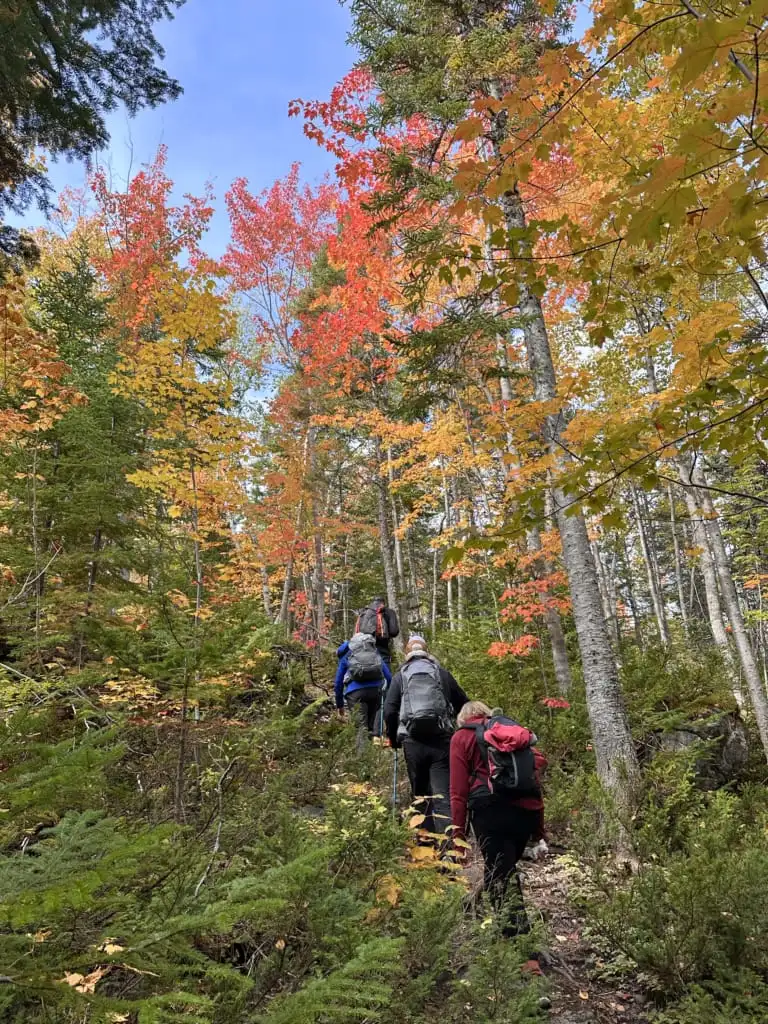
Weather in Newfoundland
Newfoundland is in the middle of the cold North Atlantic Ocean so even in summer, it’s not that warm. The average summer temperature is 16°C (61°F) but on warm days you can expect temperatures up to 25°C (77°F). Keep in mind that June is spring and September is fall so it will be a bit colder in those months.
The weather is also quite unpredictable. Rain, wind, and fog are common, but you can still get lots of sunny days. Plan your itinerary with some flexibility so that you can do indoor things like museums or galleries on the worst weather days.
Be sure to pack a waterproof jacket and waterproof hiking shoes. You’ll also want a warm mid-layer like a fleece or a lightweight puffy jacket. A warm hat and gloves are also nice.
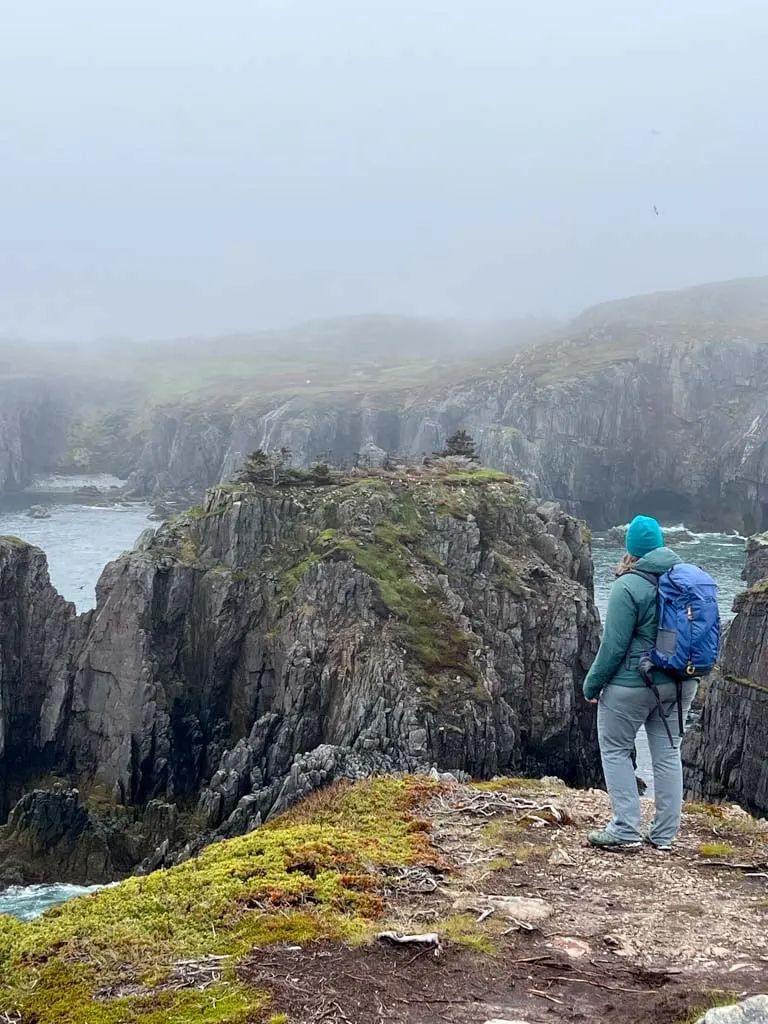
Newfoundland Time Zone
One of the quirks of Newfoundland is that it has its own time zone: Newfoundland Time (NT). And even quirkier, that time zone is 30 minutes off from the next time zone over. So if it’s noon in New York (Eastern Time), it’s 1 pm in Halifax (Atlantic Time) and 1:30 pm in St. John’s (Newfoundland Time).
Cell Phone Service in Newfoundland
While you’ll find reliable 5G cell phone service in the cities and major towns, parts of Newfoundland don’t have great cell phone service. You will get at LTE in most towns, but smaller villages will have patchy service or no service at all. As well, some highways have no service or poor service.
Make sure you download offline maps when you have service and look things up in advance. The upside is that there are road signs most places so you won’t get lost. And the locals are super friendly so can always just pull over and ask someone for directions. The only danger is that they’ll talk your ear off for 15 minutes before you can get back on the road!
Where to Stay in Newfoundland
Outside of St. John’s you won’t find chain hotels. Instead you’ll find small, locally-owned inns and guesthouses. You can book some of them on major platforms like Booking.com or VRBO, but for others you’ll have to book through their website directly.
A few places that I recommend are:
- Russelltown Inn in Bonavista: rooms in gorgeously restored heritage homes.
- Hew and Draw Hotel in Corner Brook: a gorgeous modern hotel with so many local touches
- Bonne Bay Inn in Gros Morne: A motel-style inn with incredible views of Bonne Bay and Gros Morne Mountain
- Sugar Hill Inn in Gros Mornet: A quaint inn with a huge front porch and an incredible in-house restaurant (Chanterelle’s.)

Restaurants and Grocery Stores in Newfoundland
While larger towns have lots of restaurants and groceries, if you’re heading to some of the smaller villages, options become a lot more limited. Some small villages may not have a restaurant or grocery store, or if they do, it will have limited hours or a limited menu.
If you follow any special diets (vegetarian, vegan, gluten-free, etc.) you may want to buy your groceries in a larger town and book places with a kitchen. And even if you aren’t on a special diet, it’s worth keeping enough snacks to put together a makeshift meal in case you get caught in a place where food isn’t available.
It’s also worth mentioning that the food in small villages is often very processed and/or fried and grocery stores very rarely have fresh vegetables. Expect lots of fried food and potatoes on all menus. But simple things like pasta, sandwich fixings, etc. are readily available.
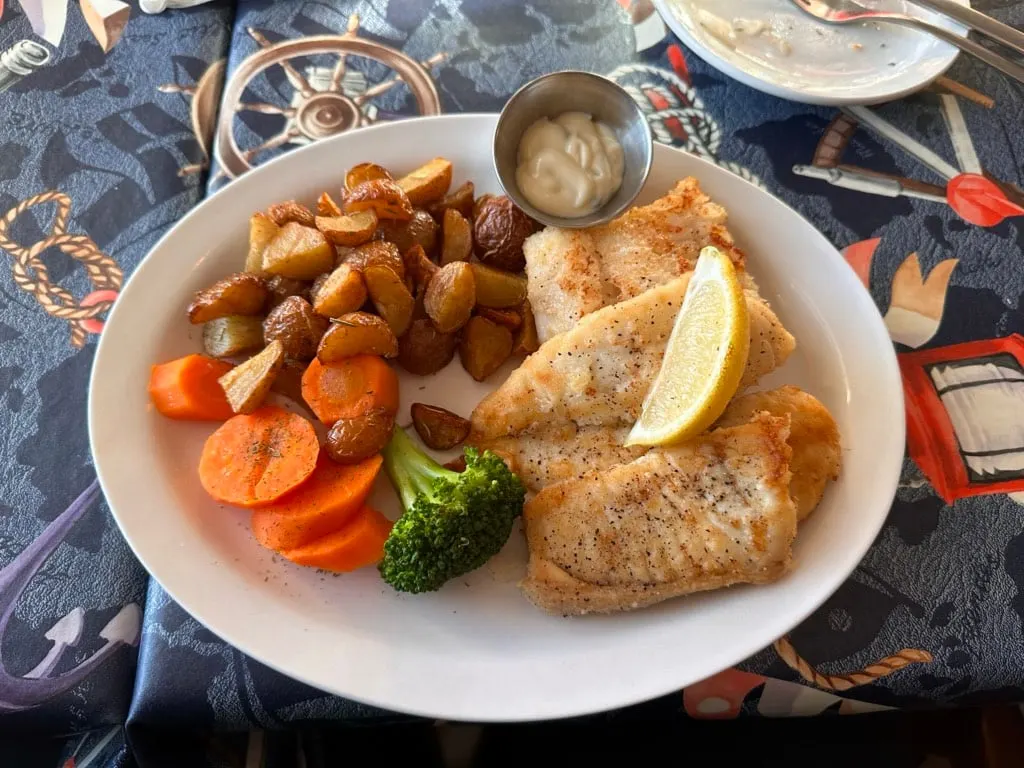
Cash and Credit Cards in Newfoundland
You’ll need both cash and credit cards in Newfoundland. Most places accept both, but there are a few that only take one or the other.
Historically, businesses in small or remote places didn’t take credit cards and wanted you to pay with cash. However, now that cell service is more widespread, now some places don’t take cash since it takes so long to get to the bank to deposit it. In particular, many businesses on Fogo Island don’t take cash.
So bring both cash and credit cards. And of course, this is Canada, so you’ll need Canadian money. Some places will accept American cash, but they take it at par, which is usually a terrible deal on the exchange rate for Americans.
Final Thoughts
In some ways, Newfoundland reminds me a bit of Iceland: incredible scenery, friendly people, and a great place for a road trip. Honestly, I’m surprised that it isn’t as popular as Iceland since they have similar vibes. However, Newfoundland has a fraction of the crowds.
If you want to visit a part of Canada that looks and feels nothing like the rest of the country, go to Newfoundland. The geography and culture as so different. From the adorable towns to the wildlife sightings to the hiking, there’s just something about this place that draws me in.
And after three trips to Newfoundland, I still haven’t seen everything. Next time I go, the Avalon Peninsula and St. Pierre and Miquelon are definitely on my list of things to do. I’d also like to hike more of the East Coast Trail and explore the Bay St. George area on the southwestern part of the island.
If you want help planning your trip to Newfoundland, I’m happy to answer your questions. Ask them in the comments or book a trip planning call with me.
READ NEXT:
- 18 Best Things to Do in St. John’s
- 12 Things To Do in Trinity
- 10 Things To Do in Bonavista
- 10 Things To Do in Twillingate
- Things to do on Fogo Island
- Things to Do in Corner Brook
- Things to Do in Gros Morne National Park
- 16 Best Hikes in Newfoundland
- My Favourite Hiking Gear of 2025 - December 9, 2025
- Best Insulated Skirts For Hiking and Snowshoeing in 2026 - December 5, 2025
- Snow-Free Hikes in Vancouver: 50+ Year-round Trails - December 4, 2025

